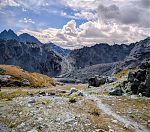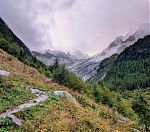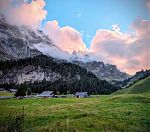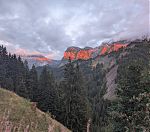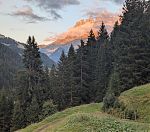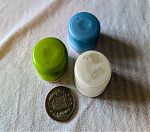15. September 2025
Swiss Peaks 170, En Route
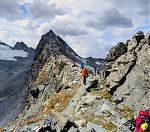 Rain arrived, plenty of it. Then some thunder. The inflatable portal set up outside of the life base in Lourtier is rocking back and forth in the wind. Clouds appeared. Mountains disappeared.
Rain arrived, plenty of it. Then some thunder. The inflatable portal set up outside of the life base in Lourtier is rocking back and forth in the wind. Clouds appeared. Mountains disappeared.
Inside the gym, mat besides mat. Who didn’t find a mat lies next to a mat. Inflatable mats for the fancy among us. None for the minimalists. Everyone’s trying to put some extra sleep in the bank. Or, effectively, making up for any sleep lost during the night before the race.
Raclette. Portion after portion. Potatoes. Then some more potatoes. Served by the crew at the checkpoint. Runners trying to put some fuel in the tank. As clouds appeared, potatoes disappeared.
Let’s rewind. It’s the Swiss Peaks 170 race. About two hundred runners lined up. Rugged terrain. Capricious course. 170km distance. 10km elevation gain. Even more elevation loss: the start at the Grande Dixence dam, the finish in Bouveret at the shores of Lac Leman.
It’s my third time at Swiss Peaks. First time at the 170k distance. When on the train to Bouveret, I was concerned. Did I reserve the shuttle to transport me to the start line the next morning? Apparently not. What an oversight! A problem already at Kilometer zero. How to solve it? No spaces left on the shuttle offered by the race. Fortunately, and likely not accidentally, there’s a connection by public bus that can get me to the start line. Phew!
I’m not the only runner who put their tent up at the Camping Rive Bleue in Bouveret. Some tents will thus remain unoccupied for a couple of nights. My stretch goal is to complete the race in under 48 hours. A comforting thought to have the tent wait for me.
Fuelled on a generous portion of Müsli, I gear up in the morning. Just when I got punctually onto the punctual train, I realized what was missing. The Leki gloves. Still in the tent. I checked only one of the two compartments of my suitcase. Kilometer zero, second problem. Consequence? Without the gloves I can transfer much less force through the poles. I can’t hike uphill the way I practiced on the days out in the mountains in the months preceding the race. I’m mildly angry at myself, even though I know it didn’t help. The experienced runners attach the gloves to the poles…
I check the opening times of sports shops: too late. Get a replacement in Orsières along the route: unlikely. Buy off a spare pair from another runner? I try it at Sion, asking a fellow competitor who’s waiting for the shuttle there. Indeed the runner has a spare pair, but it’s with his support crew at the next life base, and I’m not sure how likely he would part with them. He doesn’t offer, I don’t pursue. I decide I will just need to see how it goes. Leki poles, no gloves.
Kilometer zero. A bizarre queue forms before the cable car that transports runners from the hotel at the bottom of the dam up to the start line on top of the dam. It might be the tallest gravity dam in the world, but the elevation gain pales compared to what is ahead of us. It’s like going to the gym by escalator to then go on the stepper to work out. Anyhow, like pretty much everyone, I too save the energy and take the ride up.
Wrapped in rainproof gear, I’m waiting for the race to start. The race organisers announce that everybody will be stopped in Lourtier, about 20km and a mountain pass away. We’ll wait out the incoming bad weather there, and then restart the race. Relief. I had already been eyeing the weather forecast, played with ideas on how to avoid the bad weather, and that decision simplified things.
My fellow runners chuckle, as I apply some sunscreen. It’s cold, drizzling, and overcast. I take no chances. The start approaches, the clouds clear, the sun comes out, the runners take off. A tricky question arises. How many runners to overtake on the flat bit so I can settle on my own preferred pace on the ensuing uphill? I guess right, settle in, and follow the caravan up to the Col de Prafleuri.
Below us, a moonscape of craters, some however filled with water. Splendid weather, great visibility. A treat served right at the beginning. It nearly makes me feel guilty. Bus, cable car, some hiking, and already such a panorama.
Good. No more Kilometer zero problems. We’re on our way. Over the Col de Prafleuri through the vast emptiness of the Grande Desert, over the Col de Louvie, along a balcony trail. Things are shaping up. Legs feel fresh, as the taper removed the fatigue from the training block.
The downhill, my nemesis, meets me at the Col Termin. A flowy trail on grass marks the beginning of the descent into Lourtier. A few runners are trailing me (pun intended) and I go too fast. Eventually, I notice, and let them pass. The eccentric forces on the downhill are known to be particularly taxing on the legs. I will need them for the next 150 kilometres.
Spotting the random water outlet in the field that saved the day a couple of years ago, I know it’s not long to go until Lourtier. I don’t look at my watch, the heart rate sensor is turned off. I don’t look at the map on my phone. Get to the next flag, turn, mountain pass, checkpoint, repeat. Knowing the course helps me though. The times I check distance and elevation to cover is when deciding how much water to refill at an aid station.
At Lourtier, it’s the aforementioned Raclette party. Although the party people are chilling. Roughly seven hours pass. Everyone is eager to get going again.
Get going we do. At a ridiculous pace, reflecting the pent up energy among the “locked up” runners, the race restarts on a brief downhill on the road.
After Lourtier comes a steep uphill climb to the Cabane de Brunet. This time, I misjudge how many runners to overtake, and settle on an unsustainably uphill pace; with poles, but without gloves, of course. This mistake haunts me on the remaining climb, and I readily give in to a strong urge to down several chocolate pieces at the Cabane in short succession. Revived by the chocolate, almost locked in again by the arriving runners in the little foyer, I set off again.
So far, I made one mistake downhill, one uphill. Now a reasonable flat part awaits, and I keep it chill. After climbing Mont Brulé, I pick a better pace down to Orsières, and then Prassurny.
What I love about the aid station at Prassurny, and others, is that they have some “local specialties”. That is, dishes served only at this aid station year after year. I opt for the pasta salad, then head out. A big challenge within the challenge awaits. The Fenêtre d’Arpette!
Up to Champex-Lac, where only a week earlier you could have spotted and cheered on the trail runners during UTMB, let’s say this year’s winners Tom Evans and Ruth Croft. Unable to—and not aiming to—emulate the blistering pace set by these runners, I focus on keeping a steady, soft pace, until I catch up (I am typically faster than runners in my bracket on the flats) with a group of runners in the dark of the night.
The group, sporadically formed, is moving at a very steady pace. Perfect to tame the wild Fenêtre d’Arpette. One of the runners asks me whether I wanted to buddy up for the traverse, as he was concerned about the scrambling sections; his first time on the course. The scrambling parts are within my comfort zone, and I’m glad that I was able to help a runner just like a couple of runners helped me with their company when wrestling my way up to the very same pass with stomach issues three years ago.
My stomach is fine for the entire race this year, which is pleasant. And as Tom Evans put it in his post UTMB interview with Dylan Bowman, when runners get stomach issues, it’s almost always because they’re going too hard, even if that reason is hard to accept.
I keep eating proper food at aid stations, savoury stuff, preferable. I fuel with gels on demand when I anticipate a tough climb, and chew a waffle here and there, just to keep eating. A little silicon pouch helps me stash a cookie away at an aid station, “à emporter”.
The checkpoint at Col de Forclaz, again briefly intersecting with the UTMB course. However, I don’t think that UTMB participants had to deal with the 200m of mud that surrounded the aid station we went to. Somehow, this aid station doesn’t appeal to me, and I quickly get out. Maybe too quickly because the climb up Mont d’Arpille turns into a grind. This mountain, so easily circumvented, epitomises the course: why go around a mountain, if you can go over it? There’s a trail, so why not use it?
The most beautiful rainbow rewards me though. After plodding, now at walking pace, over a flat, never ending mountain too, I arrive at the downhill. This time, my nemesis turns into a friend. I remember some practicing rounds from my training, the spirits come back, and I descend down the dozens of switchbacks in a good rhythm.
At Salvan, the life base, it’s time to regroup. The life base is cunningly fit into a garage, where I fill up with some tasty pasta Bolognese. Apparently, the folks who ran the life base at nearby Finhaut—local speciality, Bolognese—are running Salvan. I opt for some much needed sleep and change of clothes.
Refreshed, the varying course sends us up a gorge, outfitted with wooden staircases winding up the steep sides in a precarious manner. It gives way to a plateau where I make good through a few spots by jogging until the climb takes me to the Auberge de Salanfe. I take it deliberately slowly.
Grabbing a sandwich to go—that is some slices of bread and cheese—I speed through the aid station at the Auberge, and begin the next ascent to the Col de Susanfe with its peculiar landscape. Looking down in the Lac de Susanfe, incident with the Haut Cime, a summit in the prominent Dents du Midi, the pass is composed of a series of strange-looking domes.
Quickly after this highlight, I arrive at the Pas d’Encel. Wet all year round, and part exposed, part secured with partly attached chains, I’m not particularly enthusiastic about this section. I clear it deliberately, safely and cruise down towards Barme, where I reward myself with the local speciality: chocolate crepes and bread with chocolate spread.
I’m lucky, letting a participant in the 700k race set the pace on the climb out of Barme. He seems indestructible. The trail composition changes from rocks to mud. Then some more mud. Sodding and sliding. The sun paints the rock faces in red. The night settles in again. The second night, with little sleep to go by.
Over a pasture with sheep. I shoe some sheep away. The runner behind me seems a bit uncomfortable about the sheep, the sheep unusually curious about her. Then, suddenly all the sheep flock around her, standing around somewhat aimlessly. Knowing that it won’t take long for some other runners to come along and extricate her from the situation, I proceed.
In Chaux-Palin, the cottage had apparently been refurbished over the past year, explaining why it no longer houses an aid station. Too bad, it had great flair. But even the promised water stop was nowhere to be seen. Too bad, because I loaded up less water in the expectation. Luckily, I bump into a mountain biker during the night. When he noticed my wandering gaze, I explained things. He generously procured a water bottle out of the backseat of his car. Having some reservations about accepting support along the way, it seemed justified and ‘minor infraction’.
The Portes d’Hiver are the nearly the only thing separating me from Morgins. I dispose of the climb quickly, and am positively surprised by the very runnable, wide path that awaits me at the Portes. A mildly technical section down reminds me of my place, and after having cleared it somewhat painstakingly, I get to En They.
At En Tey, the trail follows a river downstream, leading over dozens of footbridges. The sound of the river makes for a refreshing change in ambiance. The few kilometres to Morgins, however, feel long. Despite the, again, very runnable trail.
Morgins offers fancy accommodation in a hotel. I gladly accept the offer and plonk down for a while. In hindsight, I should have slept a bit longer here. I clear my feet of dirt and mud, change into new socks, and set off to compete the last section of the race.
Not long after Morgins comes a checkpoint called Conche. It’s a hospitable cottage with crepe and good mood as the local speciality. The grandma wasn’t there this time, but the crepes and the good mood were. This aid station is close to Morgins, so I mostly took the good mood with me, without overstaying in this all too comfortable cottage.
My legs didn’t like the brutally steep uphill after Conche, but I successfully convinced myself to meet it with patience. After the Tour de Don comes a section that I already struggled twice with, despite its relatively gentle terrain and gradients. But this year, I acknowledged the challenge that this section holds, instead of letting me misguided by wrong expectations.
The biggest challenge was the lack of sleep. It started to affect me between the Tour de Don and the Chalet de Blanc Sé. My legs are fine. I’m moving fine. But my interpretation of what I see is going a bit funny: I see a checkpoint with multicoloured disco lighting. It turned out to be just a cottage with some coloured lights decorating its front. I see the Chalet de Blanc Sé around the corner, and then it’s nowhere to be seen. It’s a tree trunk, not a person. An abandoned railway viaduct that turned out to be just a piece of rock with some concave insets. All reminders of the large role the brain plays in interpreting the signals received from the eyes.
Anyhow, I am glad to arrive at the generator-powered Chalet de Blanc Sé, where I am treated with generous portions of pasta with ham. I snooze for a little bit, warm myself at the fireplace, and then make my way to Taney in the wee morning hours.
In Taney, I nap some more. Before I leave , I hear the briefing for the crew at the aid station to prepare for the “shorter” races. I am impressed. They are just doing such an awesome job.
A sunny day awaits. The Pas de Lovenex doesn’t pose a big obstacle today. I’m cruising downhill to Le Frenay, the last section pounding on concrete. Over the past few days, I haven’t knocked my toes against any rocks, surprisingly. I don’t think I have become even more cautious than I had already been, so maybe I’ve acquired some skills. Whatever the answer, my feet are grateful for the outcome.
Le Frenay is a friendly aid station, but I want to finish the course. The last uphill, the last obstacle course around cattle, and then onto the never-ending paths though what is infamously known among the runners as “The Forest”. This forest has crushed a few souls in the past, but it cannot get to me today. I know it well, and all the practice of going down long winded monotonous forest tracks at Uetliberg prepared me for this last challenge that all Swiss Peaks competitors must face.
The forest yields to urban area, and the course takes its final, capricious, but well-motivated turn away from the finish line: one must cross the railway before plodding along the shores of Lac Leman, where the occasional spectator—runner or bystander—cheers you on during the last few hundred meters to the finish.



